Using Cube Coarse Aggregate to Determine the Compressive Strength of Concrete by Measuring Packing Density and Using Indian Standard and ACI Methods with Variations of Testing Age and Cement Products †
Abstract
1. Introduction
2. Research Methods
- 2.1
- 2.2
- Then, the mixed form of the coarse aggregate was sorted to obtain cube-shaped coarse aggregate in 2 existing fractions, namely sizes 20 mm and 12.5 mm;
- 2.3
- The packing density of the 2 types of coarse aggregate fractions was tested to obtain the largest packing density value for the weight presentation composition of the coarse aggregate fraction, followed by combining with fine aggregate; Figure 3;
- 2.4
- 2.5
- 2.6
- After at least a day, the test object was removed from the mold and placed in a soaking place or by sprinkling the entire surface with water every day to care for the concrete [65];
- 2.7
- 2.8
- The results of the concrete compressive strength test were entered into a table and a graphic image was made;
- 2.9
- Lastly, a discussion and conclusion of the research results was carried out.
3. Research Results and Discussion
3.1. Fine Aggregate Testing
3.2. Coarse Aggregate Testing
3.3. Cement Testing
3.4. Bulk Density, Packing Density and Void Ratio Testing
3.4.1. Testing the Bulk Density of Cube-Shaped Coarse Aggregate Size 3/8″ and Size 3/16″
3.4.2. Bulk Density, Packing Density and Void Ratio Testing of FA and CA Mixtures
3.5. Concrete Mix Design
3.6. Concrete Testing
3.6.1. Workability of Concrete Mix
3.6.2. Concrete Compressive Strength Test Results
4. Conclusions
- Concrete-mix planning using the ACI method using a cube shape for the coarse aggregate and PPC cement, gives higher concrete compressive strength results with compressive strength fc’ = 24.54 MPa (7 days) and 33.74 MPa (14 days) than the design concrete using the Indian standard (IS) method with the same form of aggregate and cement, amounting to 14.21 MPa (7 days) and 16.62 MPa (14 days). Likewise, the use of coarse aggregate in the form of a mixture and OPC and PCC cement.
- The use of PPC cement in concrete provides the highest compressive strength of concrete compared to the use of OPC and PCC cement, whether using cube aggregate or mixed form, whether the curing age is 7 days or 14 days or whether the ACI or IS concrete mix design method is used.
- Concrete that uses coarse aggregate in the form of cubes produces higher compressive strength than using coarse aggregate in the form of a mixture when using different cements, different curing times and different methods of designing concrete.
- The longest curing age, namely 14 days, has a higher compressive strength of concrete than 7 days for variations in coarse aggregate form, cement variations and variations in concrete design methods.
- Feasibility or whether or not the above research method can be applied to direct work in the field needs to be considered at the scale of the work, for research or small-scale work that can be carried out and allows the implementation of the method, selecting aggregates with sufficient energy and time which is sufficient too. For large-scale work/applications in the field, it is necessary to have a crushing plant/quarry that provides certain aggregate shapes, so that there is no need to sort the aggregate shapes. Therefore, if in the future there is a crushing plant/quarry that provides a certain form of aggregate to be offered, then the method above can be applied to large-scale work.
Author Contributions
Funding
Institutional Review Board Statement
Informed Consent Statement
Data Availability Statement
Conflicts of Interest
References
- Tjokrodimuljo, K. Teknologi Beton; Jurusan Teknik Sipil, Fakultas Teknik Universitas Gadjah Mada: Yogyakarta, Indonesia, 2007. [Google Scholar]
- Mulyono, T. Teknologi Beton; Andi Offset: Yogyakarta, Indonesia, 2004. [Google Scholar]
- Neville, A.M.; Brooks, J.J. Concrete Technology; Longman Scientific & Technical: London, UK, 1987. [Google Scholar]
- Nugraha, P.d.A. Teknologi Beton dan Material, Pembuatan, ke Beton Kinerja Tinggi; Andi Offset: Yogyakarta, Indonesia, 2007. [Google Scholar]
- Collis, L.; Smith, M.R. Aggregates: Sand, Gravel, and Crushed Rock Aggregate for Construction Purposes; Geological Society of London: London, UK, 1985. [Google Scholar]
- ASTM D-4791-95; Standard Test Method for Flat Particles, Elongated Particles, or Flat and Elongated Particles in Coarse Aggregate. ASTM Committee on Standards: West Conshohocken, PA, USA, 2023.
- Narasimha, R.; Patil, G.S.; Bhattacharjee, B. Concrete Mix Design By Packing Density Method; Indian Institute of Technology: Delhi, India, 2014. [Google Scholar]
- Wong, H.H.; Kwan, A.K. Packing Density: A Key Concept for Mix Design of High Performance Concrete. Available online: https://www.alccofine.com/wp-content/uploads/dlm_uploads/2015/02/Packing-Density-Prof-Albert-KWAN.pdf (accessed on 31 March 2025).
- Tanpure, R.P. Concrete Mix Design By Packing Density Method. IJSART 2023, 9, 1217–1227. [Google Scholar]
- Adiguno, D.W. Pengaruh Packing Density Method dan Cara Perawatan Terhadap Mutu Beton Umur 1 Hari dengan Bahan Tambahan Fly Ash Abu Limbah Batu Bara; Program Studi Teknik Sipil Fakultas Teknik Universitas Muhammadiyah Surakarta: Surakarta, Indonesia, 2017. [Google Scholar]
- Wibowo, D.B. Kuat Lentur Beton Menggunakan Blended Cement Pada Variasi Umur Perawatan, Komposisi Semen Dan Fly Ash Menggunakan Metode Packing Density Dan ACI; Fakultas Teknik, Jurusan Teknik Sipil, Universitas Muhammadiyah Surakarta: Surakarta, Indonesia, 2020. [Google Scholar]
- ACI PRC-211.1-22—Selecting Proportions for Normal-Density and High-Density Concrete Guide. 2022. Available online: https://storethinghiem.vn/uploads/files/31-ACI%20211.1-22.pdf (accessed on 31 March 2025).
- Oluwasola, E.A.; Afolayan, A.; Ipindola, O.O.; Popoola, M.O.; Oginni, A.O. Effect of Aggregate Shapes on the Properties of Concrete. LAUTECH J. Civ. Environ. Stud. 2020, 5, 1–10. [Google Scholar] [CrossRef] [PubMed]
- Birli, A. Workability of Concrete? Types & Effects on Concrete Strength. Available online: https://www.ultratechcement.com/for-homebuilders/home-building-explained-single/descriptive-articles/what-is-workability-of-concrete (accessed on 31 March 2025).
- Konitufe, C.; Abubakar, A.; Baba, A.S. Influence of Aggregate Size and Shape on the Compressive Strength of Concrete. Construction 2023, 3, 15–22. [Google Scholar] [CrossRef]
- Wong, I.L.K. Effect compressive strength and split tensile strength of concrete using aggregate from Tana Toraja district with fly ash substitution. IOP Conf. Ser. Earth Environ. Sci. 2021, 921, 012066. [Google Scholar] [CrossRef]
- Brown, R.H.; Marek, C.R. Effect of crusher operation on coarse aggregate shape. In The Concrete Producer; Publication #J96257; The Aberdeen Group: Waltham, MA, USA, 1996. [Google Scholar]
- Ozen, M. Investigation of Relationship Between Aggregate Sahpe Parameter and Concrete Strength Using Imaging Techniques. Master’s Thesis, Middle East Technical University, Ankara, Turkey, April 2007. [Google Scholar]
- Molugaram, K.; Shanker, J. A Study on Influence of Shape of Aggregate on Strength and Quality of Concrete for Buildings and Pavements. Adv. Mater. Res. 2014, 944, 776–779. [Google Scholar] [CrossRef]
- Polat, R.; Yadollahi, M.M.; Sagsoz, A.E.; Arasan, S. The Correlation between Aggregate Shape and Compressive Strength of Concrete. Int. J. Struct. Civ. Eng. Res. 2013, 2, 62–80. [Google Scholar]
- Ramos, M.; Smith, M.R.; Kojovic, T. Aggregate shape—prediction and control during crushing. Quarr. Manag. 1994, 21, 23–30. [Google Scholar]
- Site, S. Chapter 35—Shape, Surface Texture, Surface Area, and Coatings|Significance of Tests and Properti. pp. 1–9. Available online: https://asmedigitalcollection.asme.org/astm-ebooks/book/1258/chapter-abstract/27788022/Chapter-35-Shape-Surface-Texture-Surface-Area-and?redirectedFrom=fulltext (accessed on 31 March 2025).
- Yehia, S.; Abdelfatah, A.; Mansour, D. Effect of aggregate type and specimen configuration on concrete compressive strength. Crystals 2020, 10, 625. [Google Scholar] [CrossRef]
- Meshram, K.; Goliya, H.S. Effect of Shape of Aggregate on Pavement Quality Concrete. Indian Highway 2013, 41, 35–42. [Google Scholar]
- Bouquety, M.N.; Descantes, Y.; Barcelo, L.; de Larrard, F.; Clavaud, B. Experimental study of crushed aggregate shape. Constr. Build. Mater. 2007, 21, 865–872. [Google Scholar] [CrossRef]
- Kaplan, M.F. Furthur Tests of Dynamically Loaded Beams. ACI J. Proc. 1959, 55, 1193–1208. [Google Scholar] [CrossRef]
- Aïssoun, B.M.; Hwang, S.D.; Khayat, K.H. Influence of aggregate characteristics on workability of superworkable concrete. Mater. Struct. Constr. 2016, 49, 597–609. [Google Scholar] [CrossRef]
- Kalra, M.; Mehmood, G. A Review paper on the Effect of different types of coarse aggregate on Concrete. IOP Conf. Ser. Mater. Sci. Eng. 2018, 431, 082001. [Google Scholar] [CrossRef]
- Hong, L.; Gu, X.-L.; Lin, F.; Gao, P.; Sun, L.-Z. Effects of Coarse Aggregate Form, Angularity, and Surface Texture on Concrete Mechanical Performance. J. Mater. Civ. Eng. 2019, 31, 0002849. [Google Scholar] [CrossRef]
- Azevedo, N.M.; Lemos, J.V. Aggregate shape influence on the fracture behaviour of concrete. Struct. Eng. Mech. 2006, 24, 411–427. [Google Scholar] [CrossRef]
- Al-Rousan, T.; Masad, E.; Tutumluer, E.; Pan, T. Evaluation of image analysis techniques for quantifying aggregate shape characteristics. Constr. Build. Mater. 2007, 21, 978–990. [Google Scholar] [CrossRef]
- Cruz-Matías, I.; Ayala, D.; Hiller, D.; Gutsch, S.; Zacharias, M.; Estradé, S.; Peiró, F. Sphericity and roundness computation for particles using the extreme vertices model. J. Comput. Sci. 2019, 30, 28–40. [Google Scholar] [CrossRef]
- Fernlund, J.M.R. Image analysis method for determining 3-D shape of coarse aggregate. Cem. Concr. Res. 2005, 35, 1629–1637. [Google Scholar] [CrossRef]
- Gu, X.; Tran, Y.; Hong, L. Quantification of coarse aggregate shape in concrete. Front. Struct. Civ. Eng. 2014, 8, 308–321. [Google Scholar] [CrossRef]
- Hong, L.; Gu, X.; Lin, F. Influence of aggregate surface roughness on mechanical properties of interface and concrete. Constr. Build. Mater. 2014, 65, 338–349. [Google Scholar] [CrossRef]
- Kuo, C.-Y.; Freeman, R.B. Imaging Indices for Quantification of Shape, Angularity, and Surface Texture of Aggregates. Transp. Res. Rec. 2000, 1721, 57–65. [Google Scholar] [CrossRef]
- Pan, T.; Liu, Y.; Tutumluer, E. Microstructural Mechanisms of Early Age Cracking Behavior of Concrete: Fracture Energy Approach. J. Eng. Mech. 2011, 137, 439–446. [Google Scholar] [CrossRef]
- Rocco, C.G.; Elices, M. Effect of aggregate shape on the mechanical properties of a simple concrete. Eng. Fract. Mech. 2009, 76, 286–298. [Google Scholar] [CrossRef]
- Wills, M.H. How Aggregate Particle Shape Influences Concrete Mixing Water Requirement and Strength. J. Mater. 1967, 2, 843–865. [Google Scholar]
- Darvishvand, H.R.; Taghia, S.A.H.S.; Ebrahimi, M. The effect of size and shape of aggregate on compressive strength and ductility of concrete. Cem. Wapno. Bet. 2021, 2021, 46–54. [Google Scholar] [CrossRef]
- Lees, G.; Kennedy, C.K. Quality, shape and degradation of aggregates. Q. J. Eng. Geol. 1975, 8, 193–209. [Google Scholar] [CrossRef]
- Lie, H.A.; Nurhuda, I.; Setiawan, Y. The Effect of Aggregate Shape and Configuration to the Concrete Behavior. Smart Sci. 2014, 2, 85–90. [Google Scholar] [CrossRef]
- Nisa, M.U. Study to Find Out Shape Effect of Coarse Aggregate on Workability and Compressive Strength of Concrete. Int. J. Res. Appl. Sci. Eng. Technol. 2021, 9, 136–141. [Google Scholar] [CrossRef]
- Poloju, K.K. Properties of Concrete as Influenced by Shape and Texture of Fine Aggregate. Am. J. Appl. Sci. Res. 2017, 3, 28. [Google Scholar] [CrossRef]
- Kwan, A.K.H.; Mora, C.F.; Chan, H.C. Cement and Concrete Research Particle shape analysis of coarse aggregate using digital image processing. Cem. Concr. Res. 1998, 28, 921–932. [Google Scholar]
- Fowler, D.W.; Allen, J.J.; Folliard, K.J.; Kreger, M.E. The Effect of the Aggregates Characteristics on the Performance of Portland Cement Concrete Committee; University of Texas at Austin: Austin, TX, USA, 2003. [Google Scholar]
- SNI-15-2049-2004; Semen Portland. Badan Standarisasi Nasional: Jakarta, Indonesia, 2004.
- SNI 15-2049-2015; Karakteristik Kimia Semen Portland. Badan Standarisasi Nasional: Jakarta, Indonesia, 2015.
- ASTM C-150; Specification for Portland Cement. ASTM Internasional: West Conshohocken, PA, USA, 2024.
- SNI 15-2530-1991; Metode Pengujian Kehalusan Semen Portland. Badan Standarisasi Nasional: Jakarta, Indonesia, 1991.
- SNI 15-2531-1991; Metode Pengujian Berat Jenis Semen Portland. Badan Standarisasi Nasional: Jakarta, Indonesia, 1991.
- SNI 03-4806-1998; Metode Pengujian Kadar Semen Portland Dalam Beton Segar Dengan Cara Titrasi Volumetri. Badan Standarisasi Nasional: Jakarta, Indonesia, 1998.
- SNI-03-2816-1992; Metode Uji Bahan Organik dalam Agregat Halus untuk Beton. Badan Standarisasi Nasional: Jakarta, Indonesia, 1992.
- SNI 03-1970-2008; Cara Uji Berat Jenis dan Penyerapan Agregat Halus. Badan Standarisasi Nasional: Jakarta, Indonesia, 2008.
- SNI 03-2816-1992; Metode Pengujian Kotoran Organik Dalam Pasir Untuk Campuran Mortar Atau Beton. Badan Standarisasi Nasional: Jakarta, Indonesia, 1992.
- SNI 03-1970-1990; Metode Pengujian Berat Jenis dan Penyerapan Air Agregat Halus. Badan Standarisasi Nasional: Jakarta, Indonesia, 1990.
- SNI 03-6820-2002; Spesifikasi Agregat Halus untuk Pekerjaan Adukan dan Plesteran dengan Bahan Dasar Semen. Badan Standarisasi Nasional: Jakarta, Indonesia, 2002.
- SNI 03-4142-1996; Metode Pengujian Jumlah Bahan Dalam Agregat yang Lolos Saringan No.200 (0,075 mm). Badan Standarisasi Nasional: Jakarta, Indonesia, 1996.
- SNI 03-1969-2008; Cara Uji Berat Jenis dan Penyerapan Air Agregat Kasar. Badan Standarisasi Nasional: Jakarta, Indonesia, 2008.
- SNI 03-4141-1996; Metode Pengujian Gumpalan Lempung dan Butir-Butir Mudah Pecah dalam Agregat. Badan Standarisasi Nasional: Jakarta, Indonesia, 1996.
- SNI 03-4137-1996; Metode Pengujian Tebal dan Panjang Rata-Rata Agregat. Badan Standarisasi Nasional: Jakarta, Indonesia, 1996.
- SNI 2458: 2008; Tata Cara Pengambilan Contoh Uji Beton Segar. Badan Standarisasi Nasional: Jakarta, Indonesia, 2008.
- SNI 1972: 2008; Cara Uji Slump Beton. Badan Standarisasi Nasional: Jakarta, Indonesia, 2008.
- SNI 03-6429-2000; Metode Pengujian Kuat Tekan Beton Silinder dengan Cetakan Silinder didalam Tempat Cetakan. Badan Standarisasi Nasional: Jakarta, Indonesia, 2000.
- SNI 03-2493-2011; Tata Cara Pembuatan dan Perawatan Benda Uji Beton. Badan Standarisasi Nasional: Jakarta, Indonesia, 2011.
- SNI-1974-2011; Cara Uji Tekan Beton Dengan Benda Uji Silinder. Badan Standarisasi Nasional: Jakarta, Indonesia, 2011.
- Adistiani, P. Pengaruh Merk Semen Terhadap Kuat Tekan Beton Dengan Perendaman Air Tawar; Fakultas Teknik, Jurusan Teknik Sipil: Yogyakarta, Indonesia, 2017. [Google Scholar]
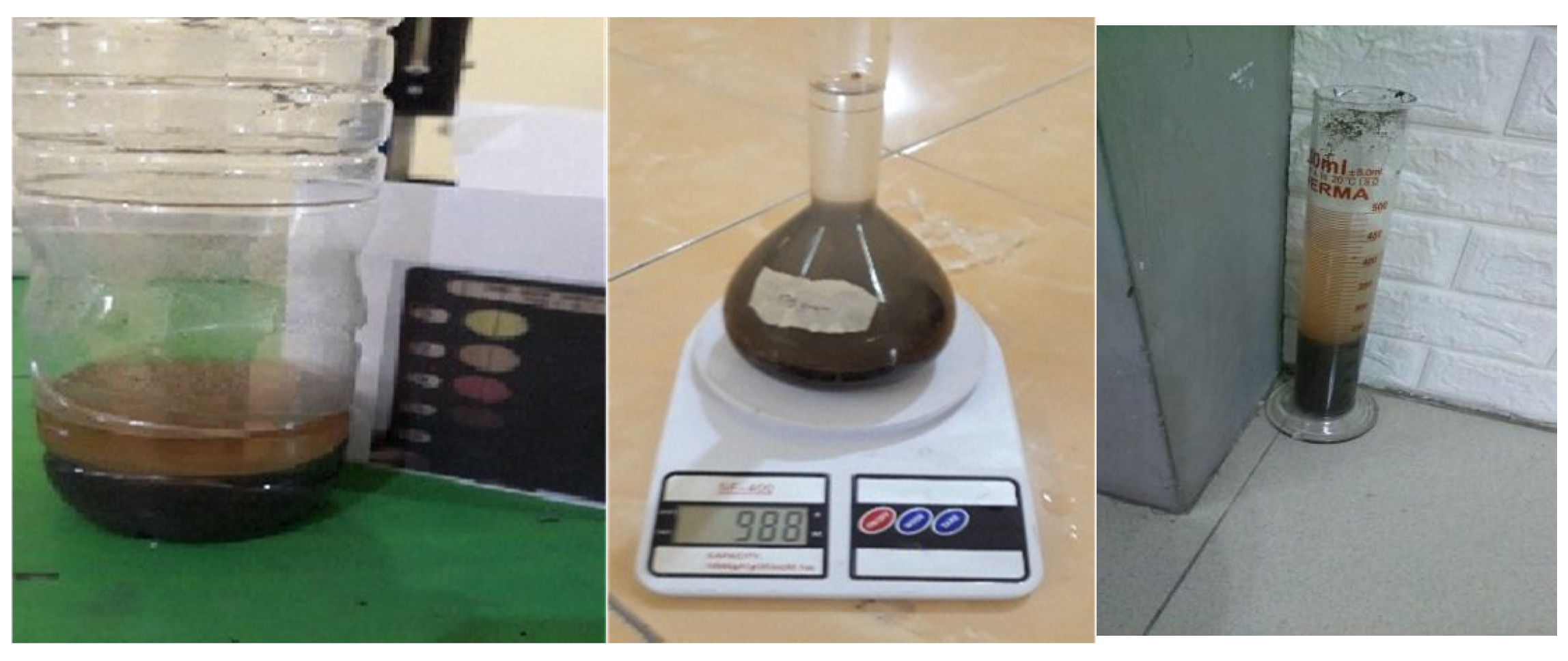
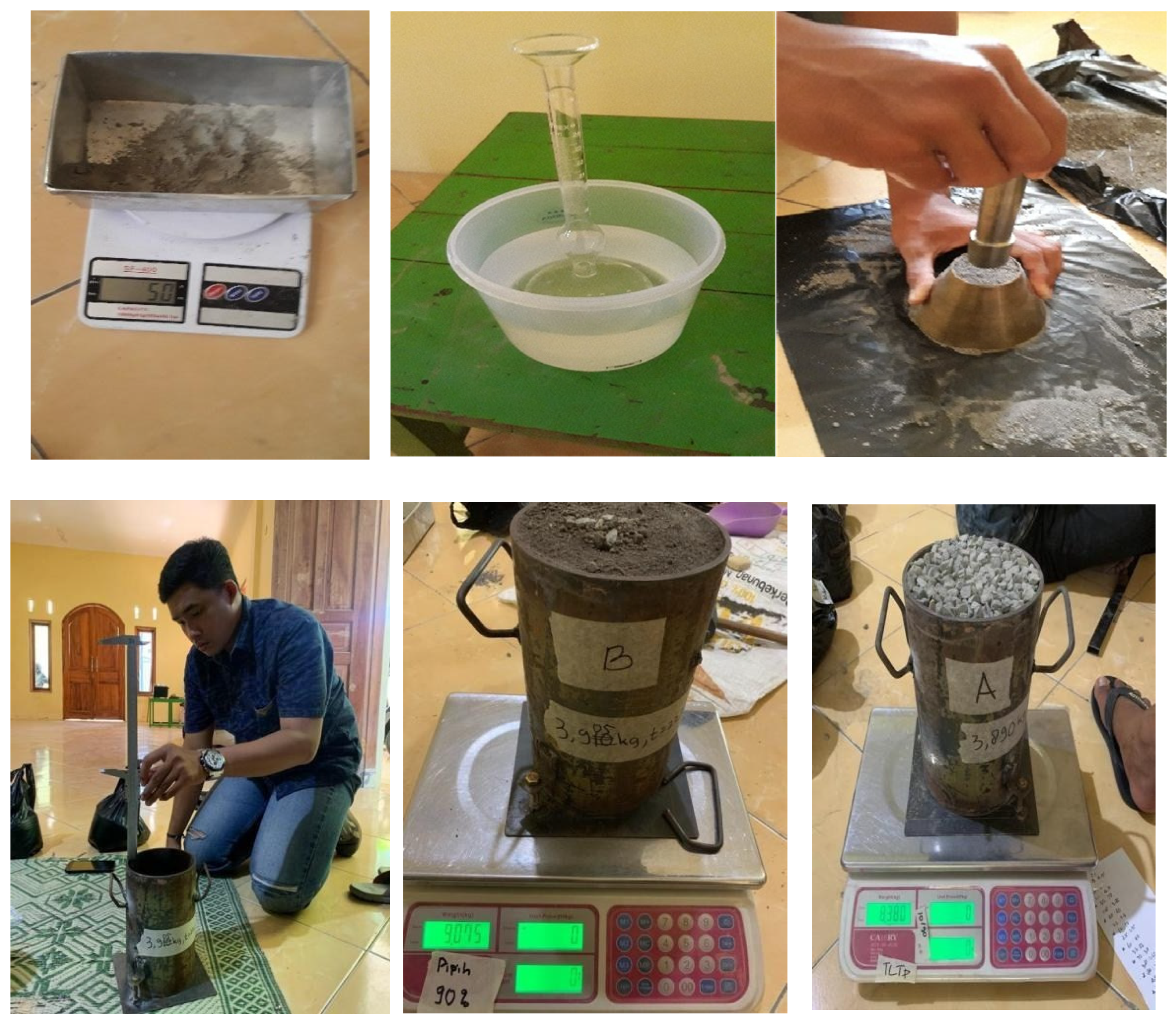
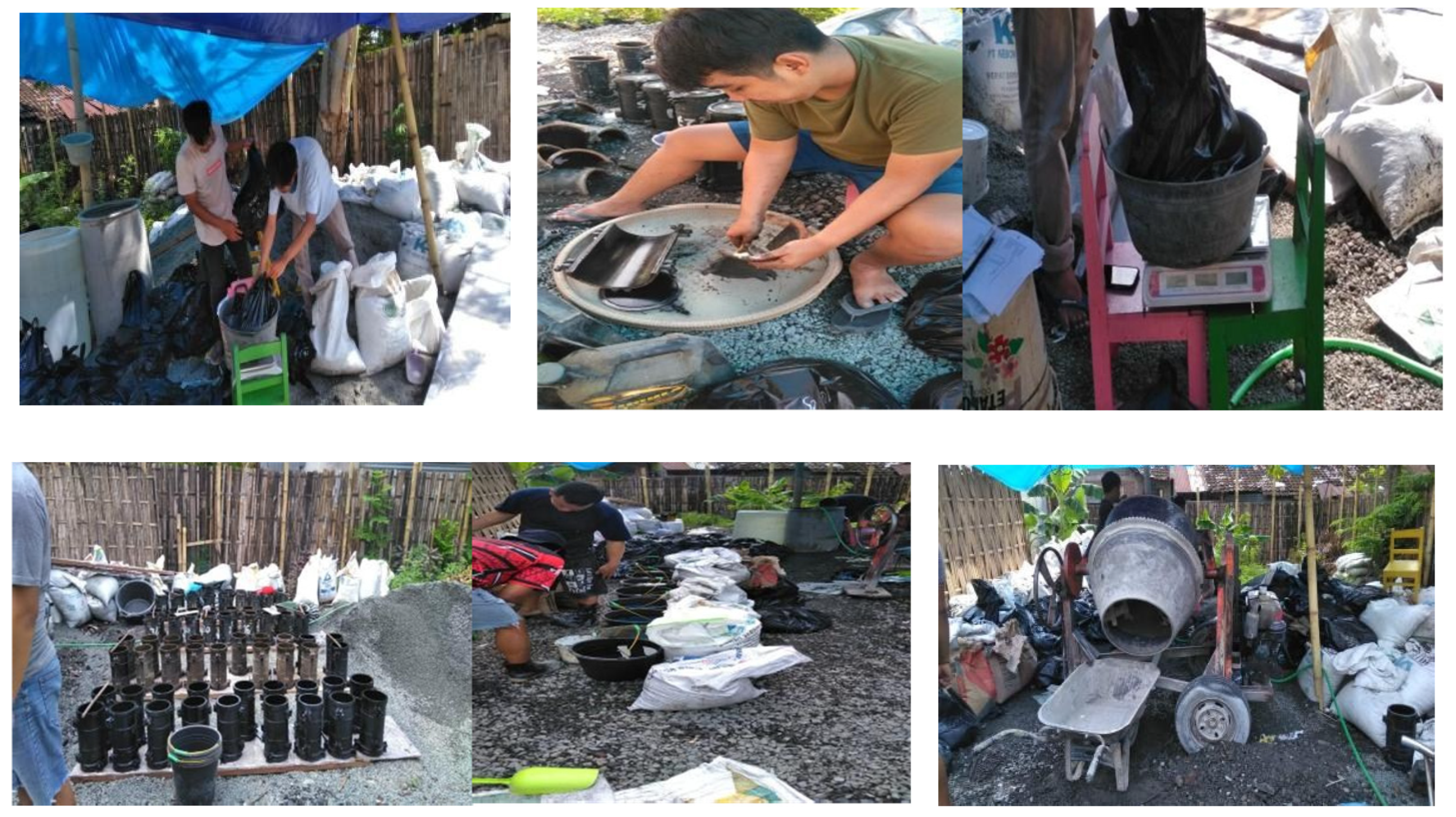
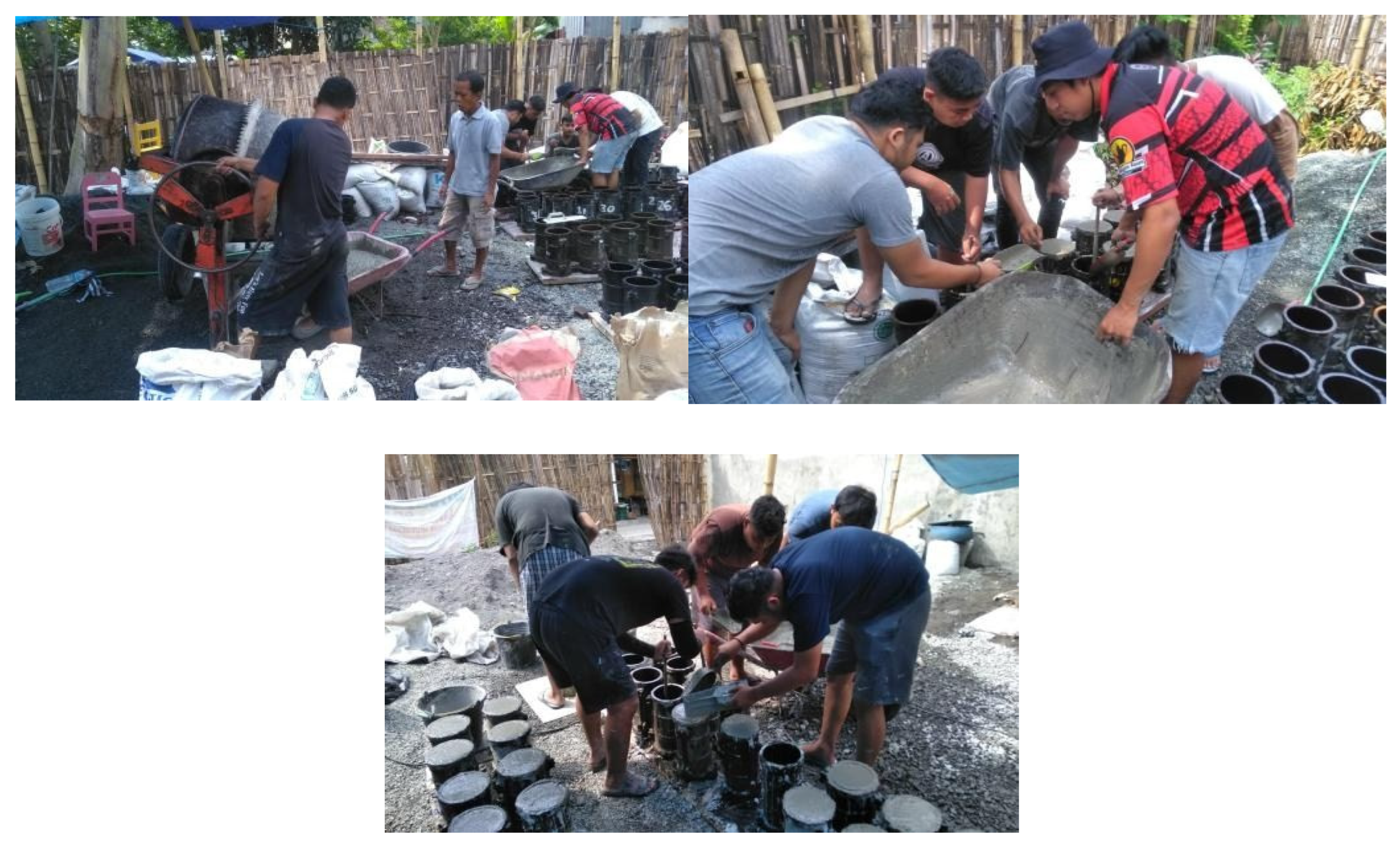
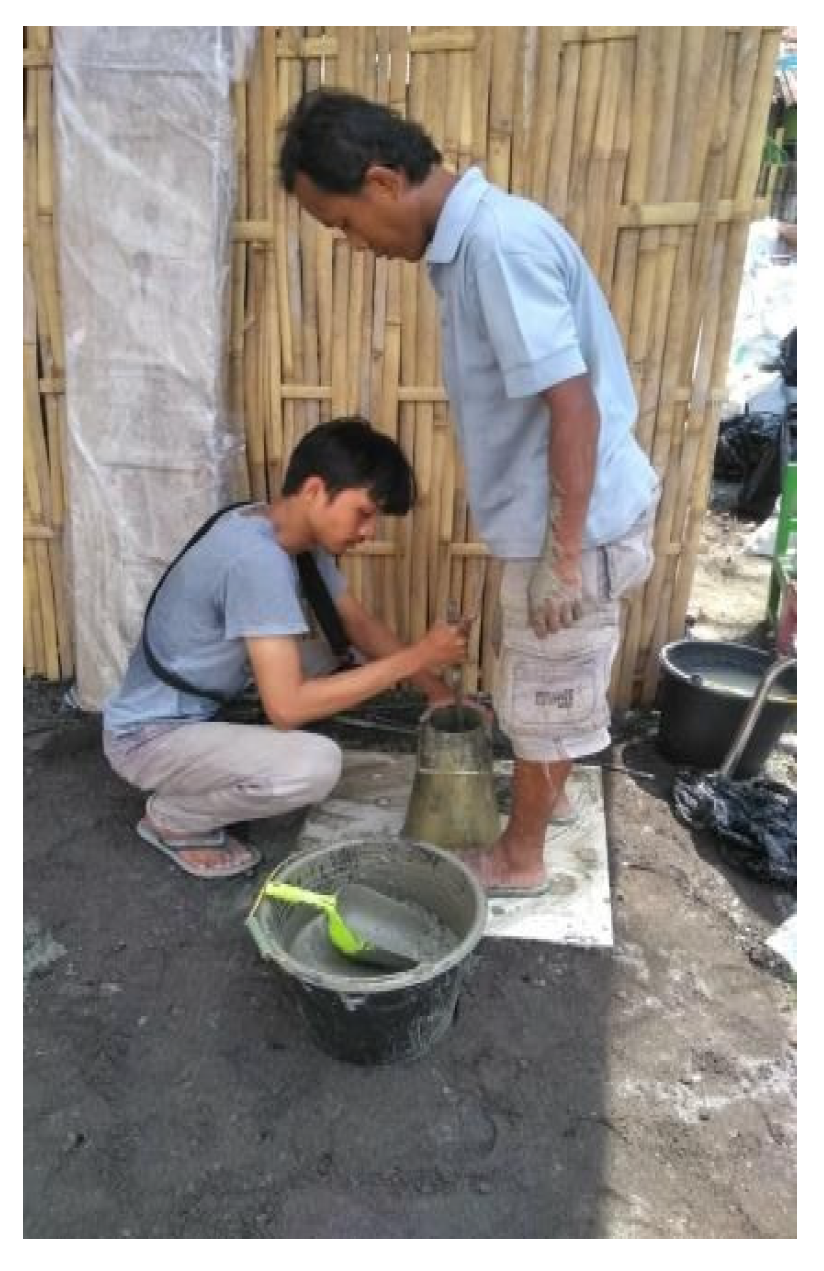
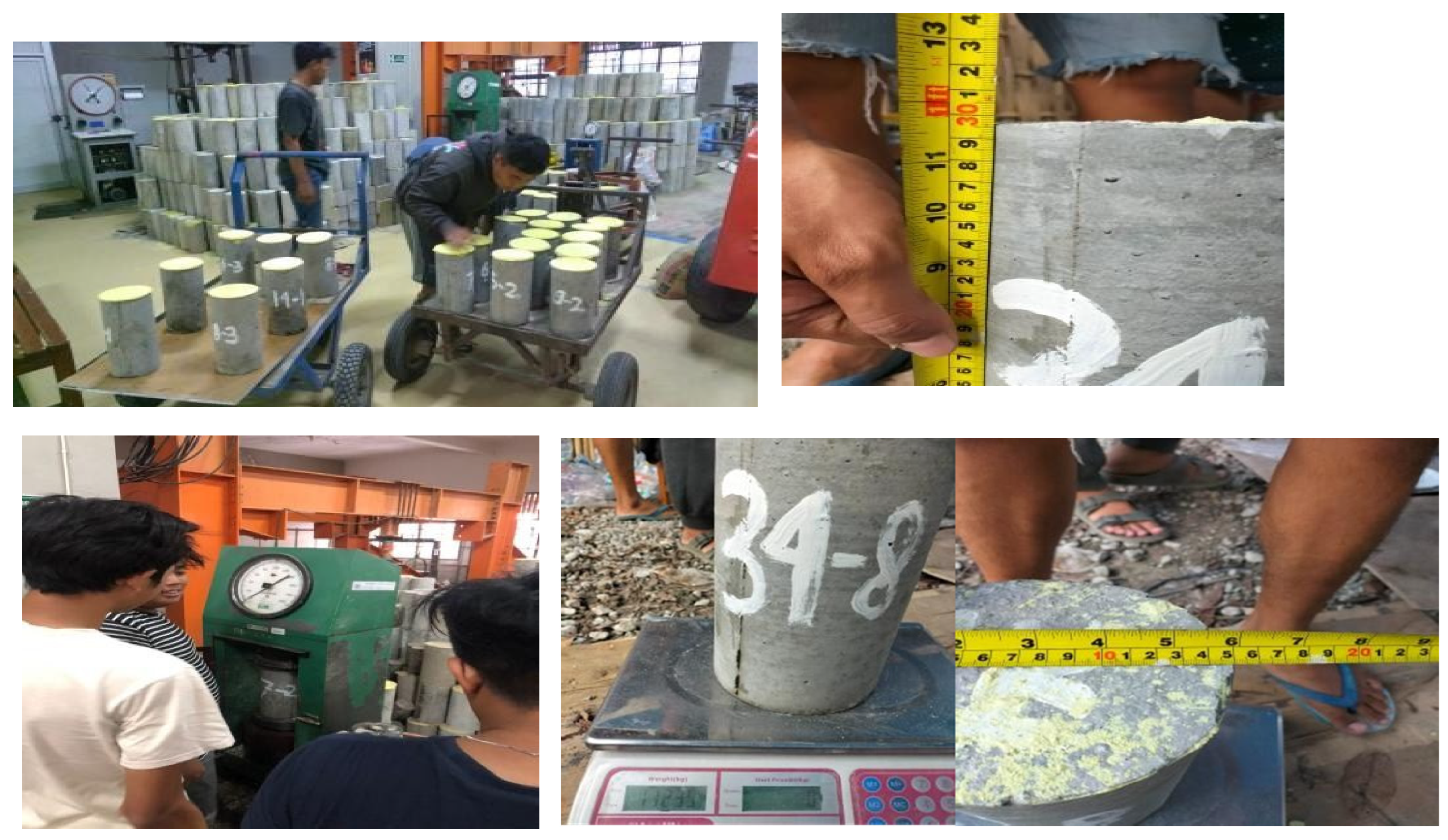
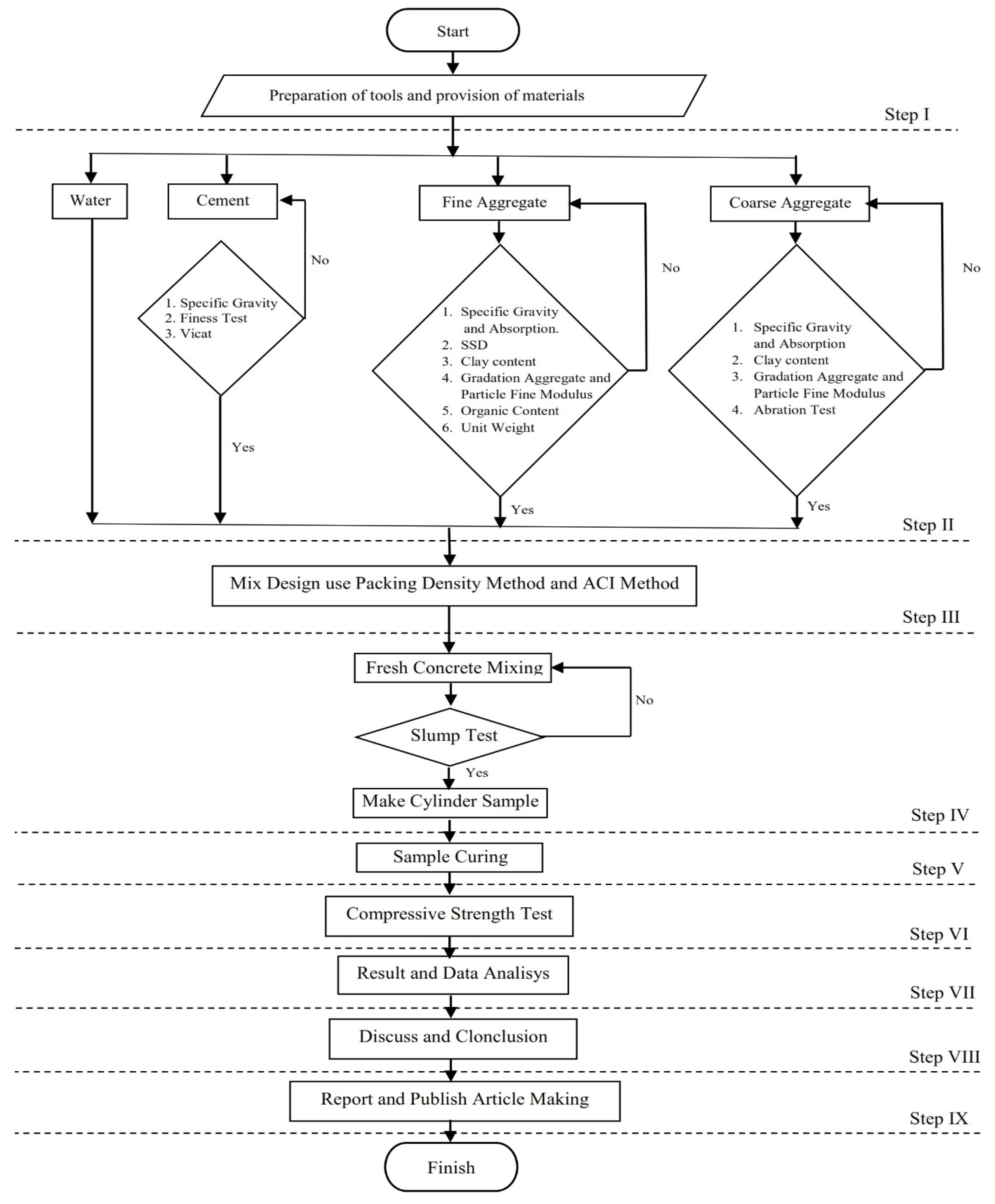
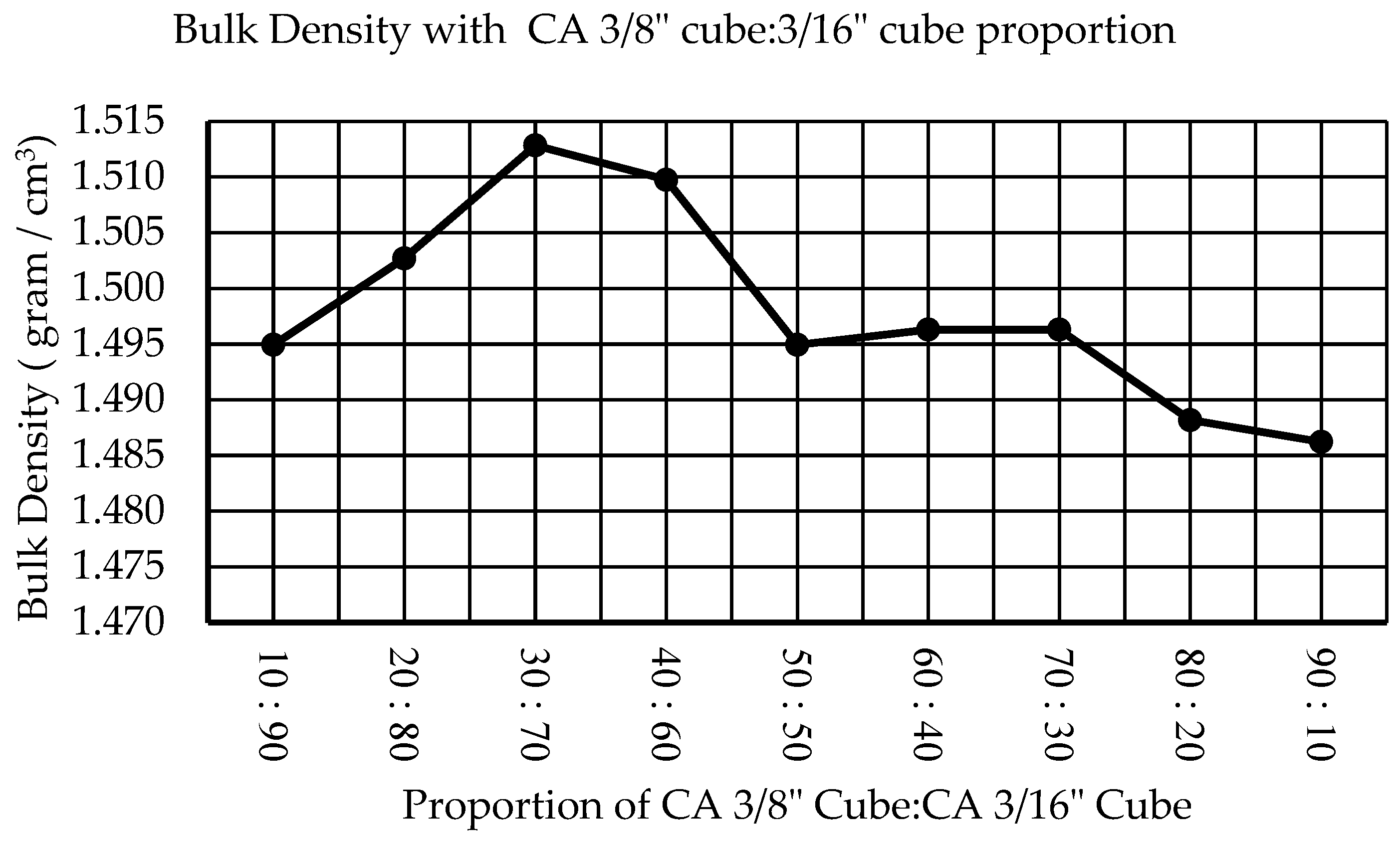




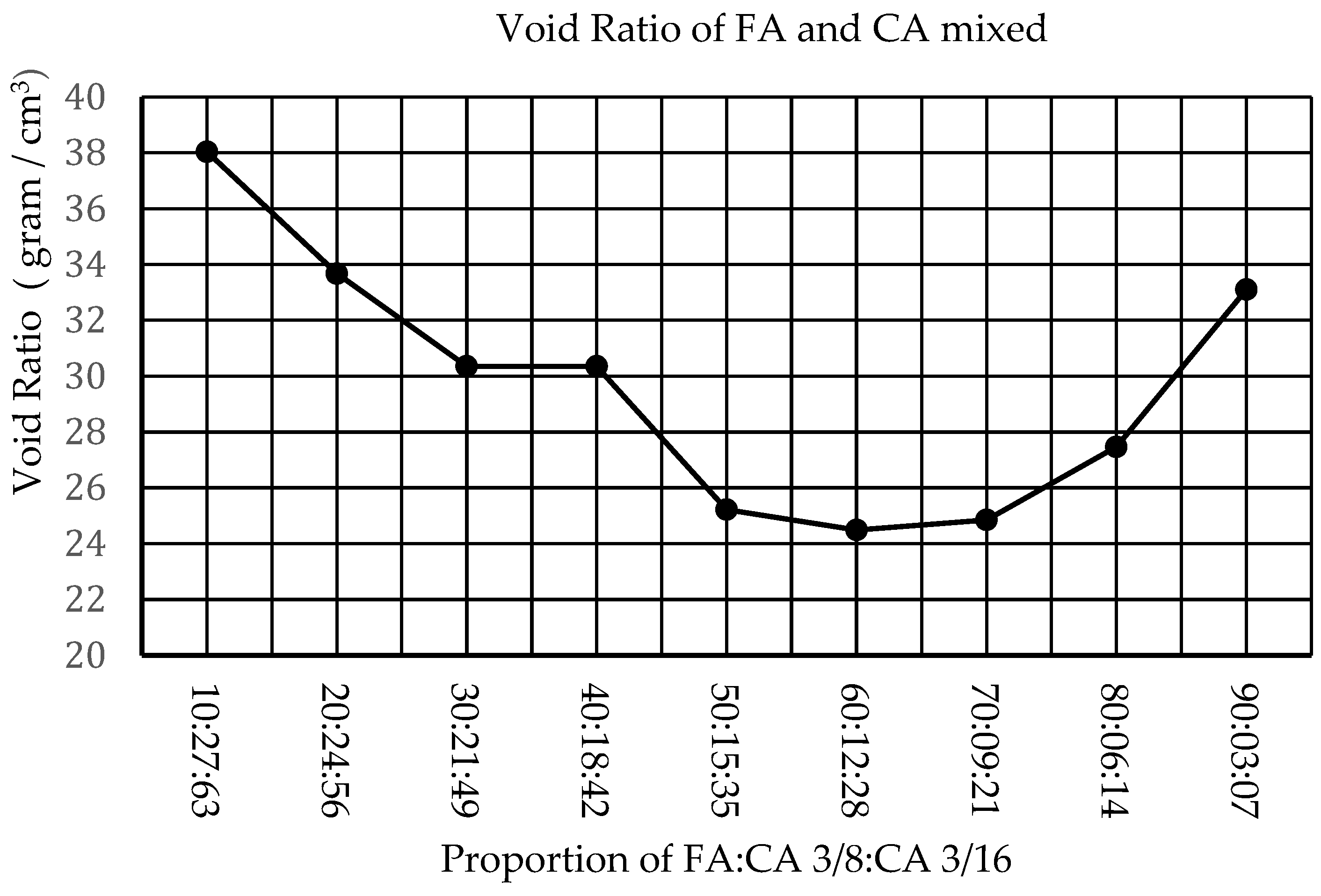
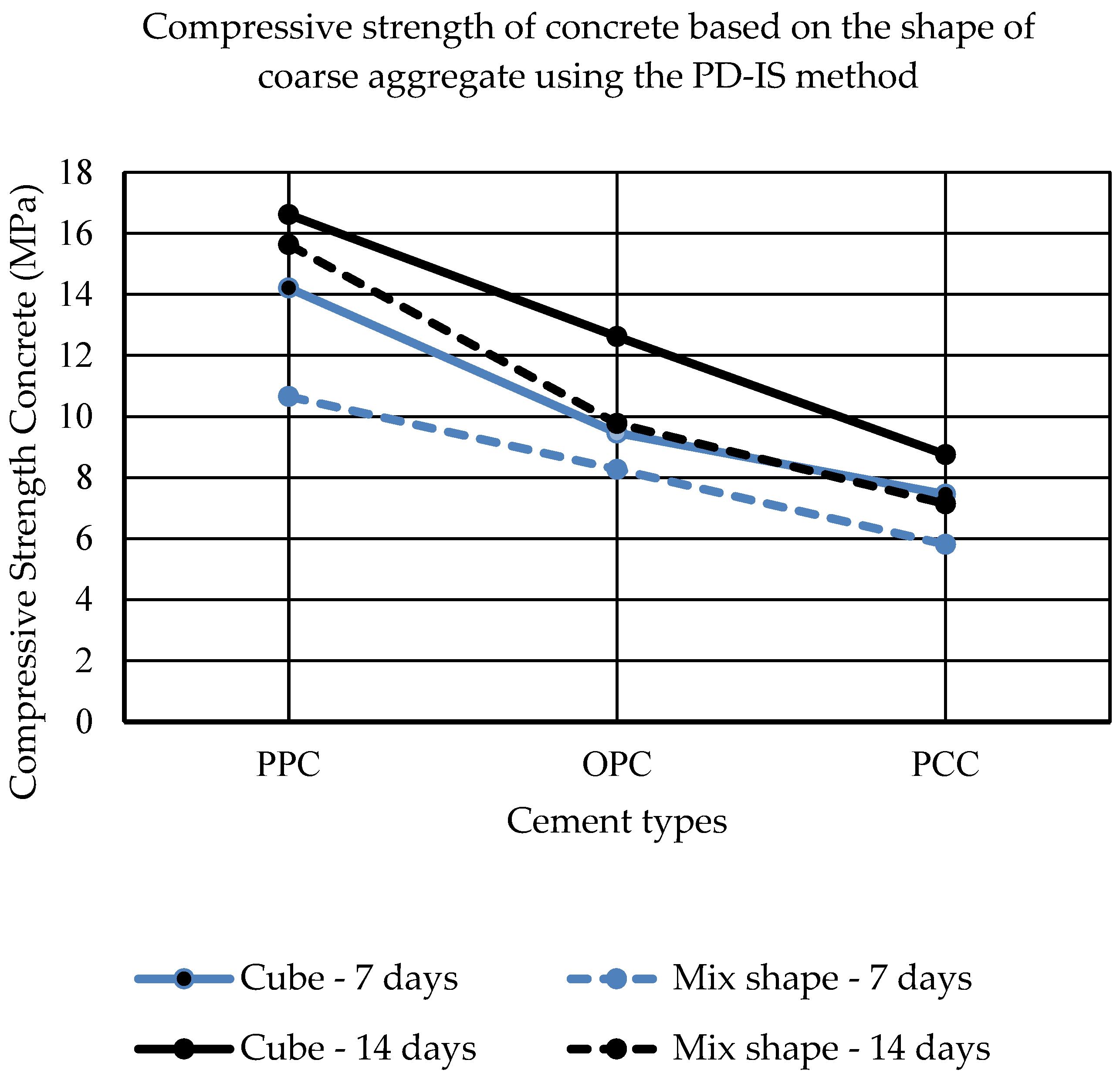
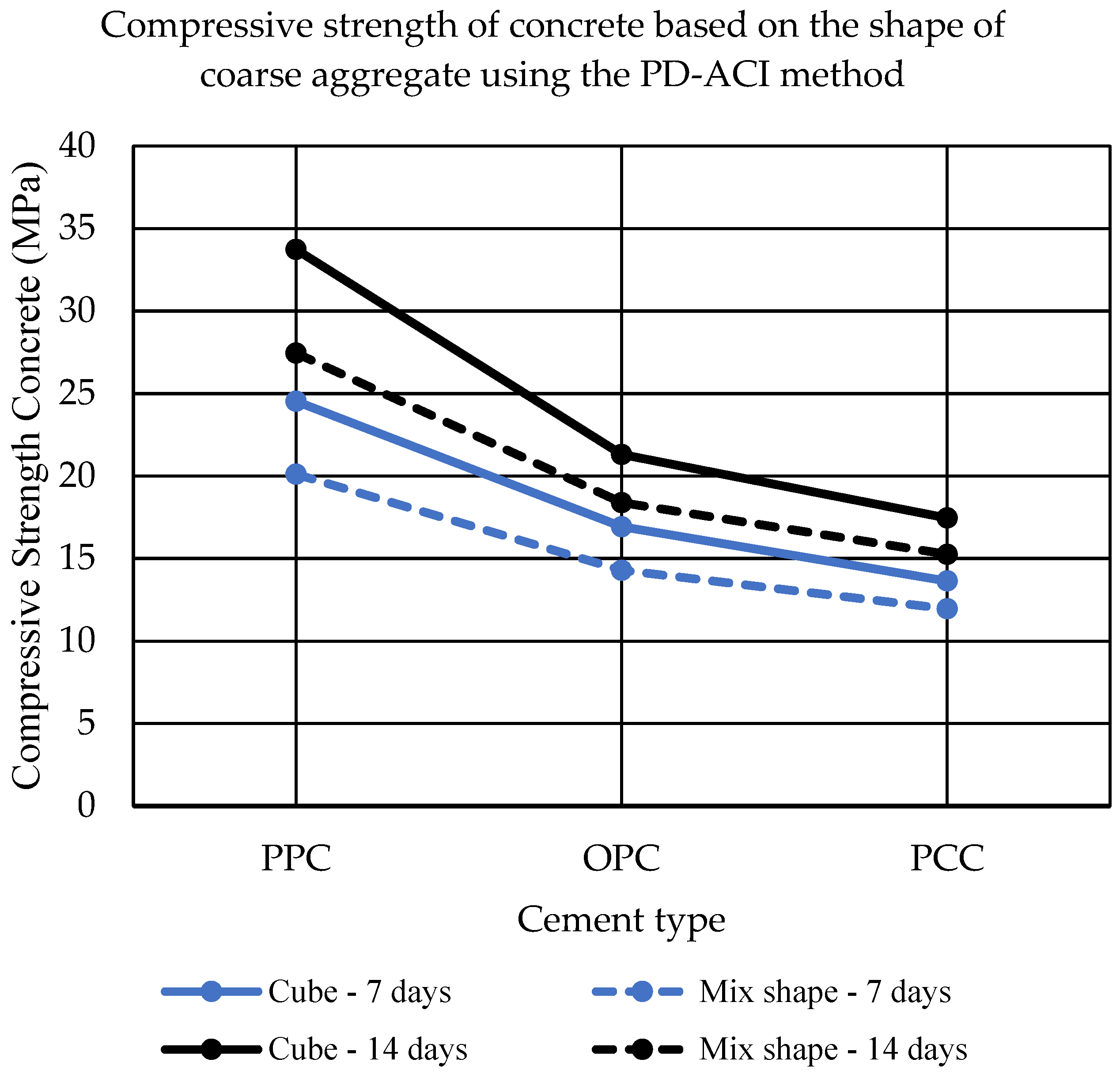
| Aggregate Proportion (%) | Aggregate Weight (g) | Total of Mix Aggregates (g) | Diameter (cm) | High (cm) | Volume (cm3) | Bulk Density (g/cm3) | ||
|---|---|---|---|---|---|---|---|---|
| 3/8″ | 3/16″ | 3/8″ | 3/16″ | |||||
| 10 | 90 | 550 | 4950 | 5500 | 13.01 | 22.27 | 2960 | 1.495 |
| 20 | 80 | 1100 | 4400 | 13.04 | 22.27 | 2974 | 1.503 | |
| 30 | 70 | 1650 | 3850 | 13.01 | 22.27 | 2960 | 1.513 | |
| 40 | 60 | 2200 | 3300 | 13.04 | 22.27 | 2974 | 1.510 | |
| 50 | 50 | 2750 | 2750 | 13.04 | 22.27 | 2960 | 1.495 | |
| 60 | 40 | 3300 | 2200 | 13.04 | 22.27 | 2974 | 1.496 | |
| 70 | 30 | 3850 | 1650 | 13.01 | 22.27 | 2974 | 1.496 | |
| 80 | 20 | 4400 | 1100 | 13.04 | 22.27 | 2960 | 1.488 | |
| 90 | 10 | 4950 | 550 | 13.01 | 22.27 | 2974 | 1.486 | |
| Weight Proportion of Course Aggregate (%) | Weight Fraction of Aggregates | Specific Gravity | Bulk Density | Maximum Packing Density | |
|---|---|---|---|---|---|
| 3/8″ | 3/16″ | (g/cm3) | (g/cm3) | ||
| 10 | 90 | 10:90 | 2.44 | 1.495 | 0.6128 |
| 20 | 80 | 20:80 | 2.44 | 1.503 | 0.6162 |
| 30 | 70 | 30:70 | 2.44 | 1.513 | 0.6204 |
| 40 | 60 | 40:60 | 2.44 | 1.510 | 0.6189 |
| 50 | 50 | 50:50 | 2.44 | 1.495 | 0.6127 |
| 60 | 40 | 60:40 | 2.44 | 1.496 | 0.6134 |
| 70 | 30 | 70:30 | 2.44 | 1.496 | 0.6135 |
| 80 | 20 | 80:20 | 2.44 | 1.488 | 0.6100 |
| 90 | 10 | 90:10 | 2.44 | 1.486 | 0.6093 |
| Weight Proportion of Course Aggregate (%) | Weight Fraction of Aggregates | Specific Gravity | Bulk Density | Minimum Void Ratio | |
|---|---|---|---|---|---|
| 3/8″ | 3/16″ | (g/cm3) | (%) | ||
| 10 | 90 | 10:90 | 2,44 | 1.495 | 38.7216 |
| 20 | 80 | 20:80 | 2,44 | 1.503 | 38.3829 |
| 30 | 70 | 30:70 | 2,44 | 1.513 | 37.9600 |
| 40 | 60 | 40:60 | 2,44 | 1.510 | 38.1072 |
| 50 | 50 | 50:50 | 2,44 | 1.495 | 38.7275 |
| 60 | 40 | 60:40 | 2,44 | 1.496 | 38.6586 |
| 70 | 30 | 70:30 | 2,44 | 1.496 | 38.6524 |
| 80 | 20 | 80:20 | 2,44 | 1.488 | 39.0032 |
| 90 | 10 | 90:10 | 2,44 | 1,486 | 39,0678 |
| Aggregate Proportion (%) | Aggregate Weight (g) | Total of Mix Aggregates (g) | Dia-Meter (cm) | High (cm) | Volume (cm3) | Bulk Density (g/cm3) | ||||
|---|---|---|---|---|---|---|---|---|---|---|
| FA | CA 3/8″ | CA 3/16″ | FA | CA 3/8″ | CA 3/16″ | |||||
| 10 | 27 | 63 | 500 | 1350 | 3150 | 5000 | 13.01 | 22.27 | 2960.5 | 1.559 |
| 20 | 24 | 56 | 1000 | 1200 | 2800 | 13.01 | 22.27 | 2960.5 | 1.669 | |
| 30 | 21 | 49 | 1500 | 1050 | 2450 | 13.01 | 22.27 | 2960.5 | 1.752 | |
| 40 | 18 | 42 | 2000 | 900 | 2100 | 13.04 | 22.27 | 2974.2 | 1.829 | |
| 50 | 15 | 35 | 2500 | 750 | 1750 | 13.01 | 22.27 | 2960.5 | 1.881 | |
| 60 | 12 | 28 | 3000 | 600 | 1400 | 13.04 | 22.27 | 2974.2 | 1.900 | |
| 70 | 9 | 21 | 3500 | 450 | 1050 | 13.01 | 22.27 | 2960.5 | 1.891 | |
| 80 | 6 | 14 | 4000 | 300 | 700 | 13.04 | 22.27 | 2974.2 | 1.825 | |
| 90 | 3 | 7 | 4500 | 150 | 350 | 13.01 | 22.27 | 2960.5 | 1.683 | |
| Weight Proportion of CA and FA (%) | Weight Fraction of Aggregates | Specific Gravity | Bulk Density | Maximum Packing Density | |||
|---|---|---|---|---|---|---|---|
| FA | 3/8 | 3/16 | FA | CA | (g/cm3) | (g/cm3) | |
| 10 | 27 | 63 | 10:27:63 | 2.59 | 2.44 | 1.559 | 0.6353 |
| 20 | 24 | 56 | 20:24:56 | 2.59 | 2.44 | 1.669 | 0.6760 |
| 30 | 21 | 49 | 30:21:49 | 2.59 | 2.44 | 1.752 | 0.7056 |
| 40 | 18 | 42 | 40:18:42 | 2.59 | 2.44 | 1.752 | 0.7014 |
| 50 | 15 | 35 | 50:15:35 | 2.59 | 2.44 | 1.881 | 0.7485 |
| 60 | 12 | 28 | 60:12:28 | 2.59 | 2.44 | 1.900 | 0.7512 |
| 70 | 9 | 21 | 70:9:21 | 2.59 | 2.44 | 1.891 | 0.7430 |
| 80 | 6 | 14 | 80:6:14 | 2.59 | 2.44 | 1.825 | 0.7127 |
| 90 | 3 | 7 | 90:3:7 | 2.59 | 2.44 | 1.683 | 0.6532 |
| Weight Proportion of CA and FA (%) | Weight Fraction of Aggre- Gates | Specific Gravity | Bulk Density | Minimum Void Ratio | |||
|---|---|---|---|---|---|---|---|
| FA | 3/8 | 3/16 | FA | CA | (gram/cm3) | (%) | |
| 10 | 27 | 63 | 10:27:63 | 2.59 | 2.44 | 1.559 | 38.0392 |
| 20 | 24 | 56 | 20:24:56 | 2.59 | 2.44 | 1.669 | 33.6757 |
| 30 | 21 | 49 | 30:21:49 | 2.59 | 2.44 | 1.752 | 30.3528 |
| 40 | 18 | 42 | 40:18:42 | 2.59 | 2.44 | 1.752 | 30.3528 |
| 50 | 15 | 35 | 50:15:35 | 2.59 | 2.44 | 1.881 | 25.2174 |
| 60 | 12 | 28 | 60:12:28 | 2.59 | 2.44 | 1.900 | 24.4919 |
| 70 | 9 | 21 | 70:9:21 | 2.59 | 2.44 | 1.891 | 24.8482 |
| 80 | 6 | 14 | 80:6:14 | 2.59 | 2.44 | 1.825 | 27.4655 |
| 90 | 3 | 7 | 90:3:7 | 2.59 | 2.44 | 1.683 | 33.1051 |
| Variation | Mixture Proportion Requirements | |||||
|---|---|---|---|---|---|---|
| Cement Type | Cement Water Factor FAS | Water (lt/m3) | Cement (kg/m3) | Fine Aggregate (kg/m3) | Size Coarse Aggregate 3/8 (kg/m3) | Size Coarse Aggregate 3/16 (kg/m3) |
| PPC | 0.48 | 195.2 | 406.7 | 1037.8 | 207.6 | 484.3 |
| OPC | 0.48 | 195.6 | 407.5 | 1037.8 | 207.6 | 484.3 |
| PCC | 0.48 | 197.5 | 411.4 | 1037.8 | 207.6 | 484.3 |
| Variation | Samples | Mixture Proportion Requirements | |||||
|---|---|---|---|---|---|---|---|
| Cement Type | Cement Water Factor FAS | Water (lt/m3) | Cement (kg/m3) | Fine Aggregate (kg/m3) | Size Coarse Aggregate 3/8 (kg/m3) | Size Coarse Aggregate 3/16 (kg/m3) | |
| PPC | 0.48 | 9 Cylinders | 10.2 | 21.3 | 54.5 | 10.9 | 25.4 |
| OPC | 0.48 | 9 Cylinders | 10.3 | 21.4 | 54.5 | 10.9 | 25.4 |
| PCC | 0.48 | 9 Cylinders | 10.4 | 21.6 | 54.5 | 10.9 | 25.4 |
| Variation | Mixture Proportion Requirements | |||||
|---|---|---|---|---|---|---|
| Cement Type | Cement Water Factor FAS | Water (lt/m3) | Cement (kg/m3) | Fine Aggregate (kg/m3) | Size Coarse Aggregate 3/8 (kg/m3) | Size Coarse Aggregate 3/16 (kg/m3) |
| PPC | 0.42 | 238 | 566.67 | 843.89 | 168.77 | 393.81 |
| OPC | 0.42 | 238 | 566.67 | 845.26 | 169.05 | 394.45 |
| PCC | 0.42 | 238 | 566.67 | 852.15 | 170.43 | 397.67 |
| Variation | Samples | Mixture Proportion Requirements | |||||
|---|---|---|---|---|---|---|---|
| Cement Type | Cement Water Factor FAS | Water (lt/m3) | Cement (kg/m3) | Fine Aggregate (kg/m3) | Size Coarse Aggregate 3/8 (kg/m3) | Size Coarse Aggregate 3/16 (kg/m3) | |
| PPC | 0.42 | 9 Cylinders | 12.49 | 29.74 | 44.29 | 8.85 | 20.66 |
| OPC | 0.42 | 9 Cylinders | 12.49 | 29.74 | 44.36 | 8.87 | 20.70 |
| PCC | 0.42 | 9 Cylinders | 12.49 | 29.74 | 44.72 | 8.94 | 20.87 |
| Concrete Type | PD-IS PPC | PD-IS OPC | PD-IS PCC | PD-ACI PPC | PD-ACI OPC | PD-ACI PCC |
|---|---|---|---|---|---|---|
| Average Slump (cm) | 21 | 17 | 24 | 20.5 | 21 | 20.5 |
| Cement Type—Aggregate Shape | Average Concrete Compressive Strength (MPa) | |
|---|---|---|
| Age (Days) | ||
| 7 | 14 | |
| PPC—Cube | 14.21 | 16.62 |
| OPC—Cube | 9.46 | 12.62 |
| PCC—Cube | 7.45 | 8.75 |
| PPC—Mix shape | 10.66 | 15.63 |
| OPC—Mix shape | 8.27 | 9.77 |
| PCC—Mix shape | 5.81 | 7.14 |
| Notes: | PPC = Portland Pozolan Cement | |
| PD = Packing Density | OPC = Ordinary Portland Cement | |
| IS = Indian Standard | PCC = Portland Cement Composite | |
| Cement Type—Aggregate Shape | Average Concrete Compressive Strength (MPa) | |
|---|---|---|
| Age (Days) | ||
| 7 | 14 | |
| PPC—Cube | 24.54 | 33.74 |
| OPC—Cube | 16.93 | 21.31 |
| PCC—Cube | 13.64 | 17.46 |
| PPC—Mix shape | 20.11 | 27.46 |
| OPC—Mix shape | 14.29 | 18.39 |
| PCC—Mix shape | 11.96 | 15.26 |
| Notes: | ||
| PD = Packing Density | PPC = Portland Pozolan Cement | |
| ACI = American Concrete | OPC = Ordinary Portland Cement | |
| Institute | PCC = Portland Cement Composite | |
Disclaimer/Publisher’s Note: The statements, opinions and data contained in all publications are solely those of the individual author(s) and contributor(s) and not of MDPI and/or the editor(s). MDPI and/or the editor(s) disclaim responsibility for any injury to people or property resulting from any ideas, methods, instructions or products referred to in the content. |
© 2025 by the authors. Licensee MDPI, Basel, Switzerland. This article is an open access article distributed under the terms and conditions of the Creative Commons Attribution (CC BY) license (https://creativecommons.org/licenses/by/4.0/).
Share and Cite
Suhendro, T.; Nugroho, R.A. Using Cube Coarse Aggregate to Determine the Compressive Strength of Concrete by Measuring Packing Density and Using Indian Standard and ACI Methods with Variations of Testing Age and Cement Products. Eng. Proc. 2025, 84, 91. https://doi.org/10.3390/engproc2025084091
Suhendro T, Nugroho RA. Using Cube Coarse Aggregate to Determine the Compressive Strength of Concrete by Measuring Packing Density and Using Indian Standard and ACI Methods with Variations of Testing Age and Cement Products. Engineering Proceedings. 2025; 84(1):91. https://doi.org/10.3390/engproc2025084091
Chicago/Turabian StyleSuhendro, Trinugroho, and Ryan Adi Nugroho. 2025. "Using Cube Coarse Aggregate to Determine the Compressive Strength of Concrete by Measuring Packing Density and Using Indian Standard and ACI Methods with Variations of Testing Age and Cement Products" Engineering Proceedings 84, no. 1: 91. https://doi.org/10.3390/engproc2025084091
APA StyleSuhendro, T., & Nugroho, R. A. (2025). Using Cube Coarse Aggregate to Determine the Compressive Strength of Concrete by Measuring Packing Density and Using Indian Standard and ACI Methods with Variations of Testing Age and Cement Products. Engineering Proceedings, 84(1), 91. https://doi.org/10.3390/engproc2025084091





